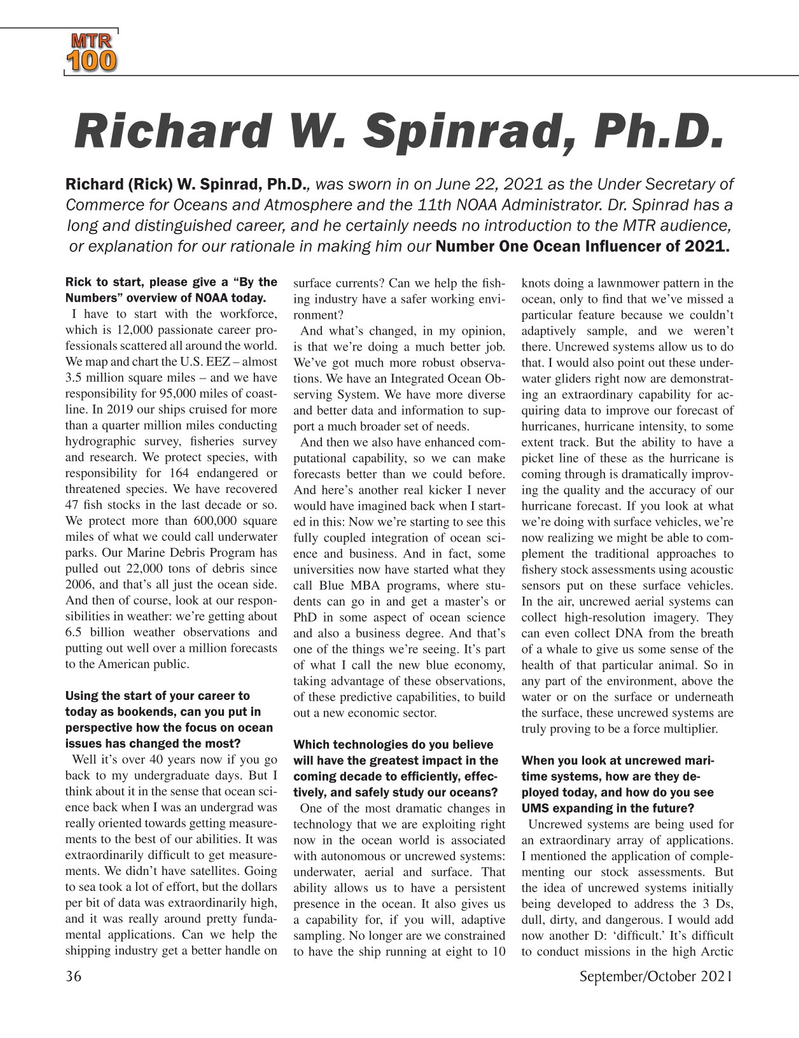
Page 36: of Marine Technology Magazine (September 2021)
MTR100: Focus on 100 Leading Companies, People and Innovations in the Subsea Space
Read this page in Pdf, Flash or Html5 edition of September 2021 Marine Technology Magazine
MTTTTTTTTTTTTTRM M M M M M M M M M M M M M M M M M M M M M M M M M M M MTRRRRRRRRRRRRRRRRRRRRRRRRRRRMTTTTTTTTTTTTTRMTR 100000000000000001111111111111111111111111111100000000000000000000000000000010000000000000000100
Richard W. Spinrad, Ph.D.
Richard (Rick) W. Spinrad, Ph.D., was sworn in on June 22, 2021 as the Under Secretary of
Commerce for Oceans and Atmosphere and the 11th NOAA Administrator. Dr. Spinrad has a long and distinguished career, and he certainly needs no introduction to the MTR audience, or explanation for our rationale in making him our Number One Ocean In? uencer of 2021.
Rick to start, please give a “By the surface currents? Can we help the ? sh- knots doing a lawnmower pattern in the
Numbers” overview of NOAA today. ing industry have a safer working envi- ocean, only to ? nd that we’ve missed a
I have to start with the workforce, ronment? particular feature because we couldn’t which is 12,000 passionate career pro- And what’s changed, in my opinion, adaptively sample, and we weren’t fessionals scattered all around the world. is that we’re doing a much better job. there. Uncrewed systems allow us to do
We map and chart the U.S. EEZ – almost We’ve got much more robust observa- that. I would also point out these under- 3.5 million square miles – and we have tions. We have an Integrated Ocean Ob- water gliders right now are demonstrat- responsibility for 95,000 miles of coast- serving System. We have more diverse ing an extraordinary capability for ac- line. In 2019 our ships cruised for more and better data and information to sup- quiring data to improve our forecast of than a quarter million miles conducting port a much broader set of needs. hurricanes, hurricane intensity, to some hydrographic survey, ? sheries survey And then we also have enhanced com- extent track. But the ability to have a and research. We protect species, with putational capability, so we can make picket line of these as the hurricane is responsibility for 164 endangered or forecasts better than we could before. coming through is dramatically improv- threatened species. We have recovered And here’s another real kicker I never ing the quality and the accuracy of our 47 ? sh stocks in the last decade or so. would have imagined back when I start- hurricane forecast. If you look at what
We protect more than 600,000 square ed in this: Now we’re starting to see this we’re doing with surface vehicles, we’re miles of what we could call underwater fully coupled integration of ocean sci- now realizing we might be able to com- parks. Our Marine Debris Program has ence and business. And in fact, some plement the traditional approaches to pulled out 22,000 tons of debris since universities now have started what they ? shery stock assessments using acoustic 2006, and that’s all just the ocean side. call Blue MBA programs, where stu- sensors put on these surface vehicles.
And then of course, look at our respon- dents can go in and get a master’s or In the air, uncrewed aerial systems can sibilities in weather: we’re getting about PhD in some aspect of ocean science collect high-resolution imagery. They 6.5 billion weather observations and and also a business degree. And that’s can even collect DNA from the breath putting out well over a million forecasts one of the things we’re seeing. It’s part of a whale to give us some sense of the to the American public. of what I call the new blue economy, health of that particular animal. So in taking advantage of these observations, any part of the environment, above the
Using the start of your career to of these predictive capabilities, to build water or on the surface or underneath today as bookends, can you put in out a new economic sector. the surface, these uncrewed systems are perspective how the focus on ocean truly proving to be a force multiplier.
issues has changed the most? Which technologies do you believe
Well it’s over 40 years now if you go will have the greatest impact in the When you look at uncrewed mari- back to my undergraduate days. But I coming decade to ef? ciently, effec- time systems, how are they de- think about it in the sense that ocean sci- tively, and safely study our oceans? ployed today, and how do you see ence back when I was an undergrad was One of the most dramatic changes in UMS expanding in the future?
really oriented towards getting measure- technology that we are exploiting right Uncrewed systems are being used for ments to the best of our abilities. It was now in the ocean world is associated an extraordinary array of applications. extraordinarily dif? cult to get measure- with autonomous or uncrewed systems: I mentioned the application of comple- ments. We didn’t have satellites. Going underwater, aerial and surface. That menting our stock assessments. But to sea took a lot of effort, but the dollars ability allows us to have a persistent the idea of uncrewed systems initially per bit of data was extraordinarily high, presence in the ocean. It also gives us being developed to address the 3 Ds, and it was really around pretty funda- a capability for, if you will, adaptive dull, dirty, and dangerous. I would add mental applications. Can we help the sampling. No longer are we constrained now another D: ‘dif? cult.’ It’s dif? cult shipping industry get a better handle on to have the ship running at eight to 10 to conduct missions in the high Arctic 36 September/October 2021
MTR #7 (34-49).indd 36 9/22/2021 2:17:13 PM

 35
35

 37
37
